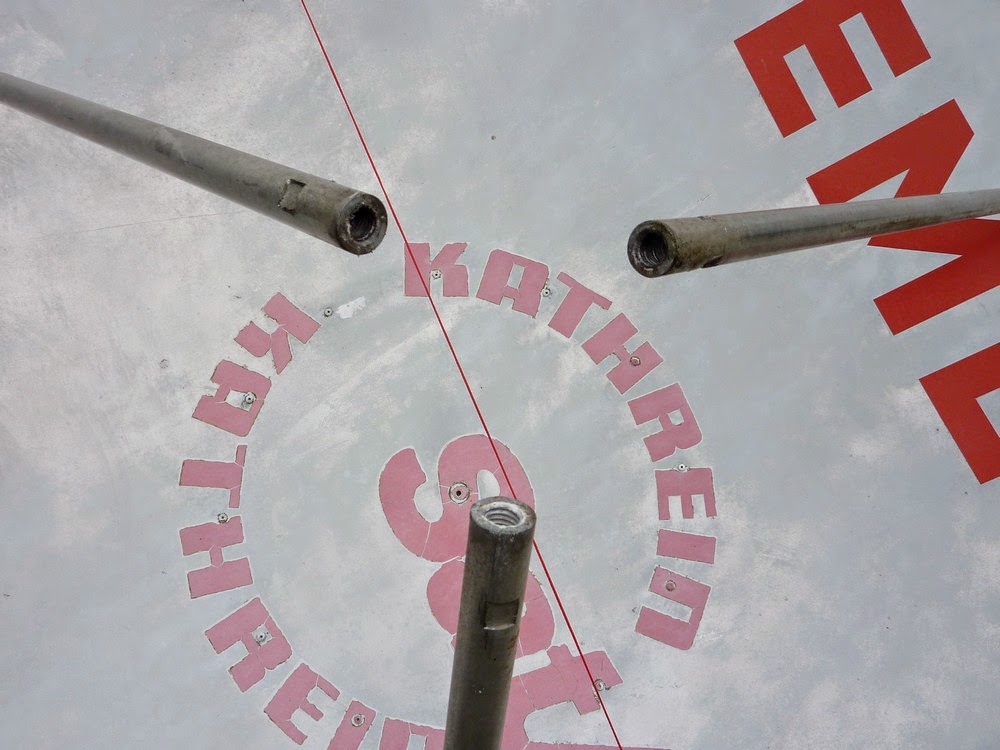(
The feedhorn projecting from the protective, feed hub, bowl. The dark green stain is probably lichen.
The three, stainless steel, socket head screws clamp the skew adjustment ring. Loosening these screws would allow the fitter to rotate the LNB to maximise the signal. They would then be tightened again to hold the LNB in perfect alignment. Squareness of the LNB to the dish's axis is vital.
The complete LNB and feedhorn removed from the protective hub. The rusty plates are simple clip on protection for the hidden electronic circuitry. No doubt they were once lightly plated. Even within the protective feed container the assembly would be subject to condensation with changing temperatures.
The frequency range is stated to be 10.95-11.7 GHz.

The rear of the bare feedhorn and skew adjustment clamping ring after removal of the LNB assembly.
The thin red line is just a tightly stretched cord for measuring the depth of the dish.
The bare, protective feed hub still attached to the support arms.
Only two of the arm fixing screws are hollow to allow coaxial cable to run inside the lower, feed support arms.
Other Kathrein dishes had a heavy, aluminium, three-eared, centre boss instead of the cup and protective can.
Note the much smaller bores of the arm fixing screws compared with my own dish. Presumably from an earlier period when smaller coaxial cable was the standard.

The protective, aluminium, feed cover is held in place on the bowl-shaped, feed boss with three socket head screws. It is made of aluminium with a coarse spray paint coating.
It is 22cm deep x 17.5cm in diameter.
The feedhorn and captive skew adjustment ring after decades of exposure to the weather.
There is no protection in the open end of the feedhorn to stop spiders entering. One spider was still living inside and there were lots of spider webs.
Modern LNBs usually have some sort of plastic screen to stop insect ingress.
The front diameter of the feedhorn which fits the large hole in the feed [bowl shaped ] boss is 63mm. The rear diameter is 60mm Ø. The skew clamping flange is 69.5mm Ø.
One of the hollow screws which clamp the feed support arms to the dish. The spanner size is 19mm. Once removed (with great difficulty!) a powdery white deposit was coating the threads. The rear screws are housed in a local dimple in the dish.
Inside the Kathrein LNB block machined from massive limps of solid aluminium alloy. The Vertical and Horizontal polarisation antennae are the small blades inside the machined housing. Modern LNBs use one wave guide leading to a pair of antennae at right angles to each other.
Another view inside the massive LNB showing part of the signal wave guide. All fixing screws are stainless steel.
The bare protective feed bowl/boss or hub from the inside.
Here the hub has been removed to show the female threads which hold the arm fixing screws. 17mm spanner/wrench flats are provided on the arms to resist torsion when fastening or loosening these fixing screws. The arms themselves are thick wall, large diameter aluminium alloy tube. I recommend that you grease the screw threads afterwards if you do manage to dismantle the hub or dish fixing screws.
I had a real struggle with one badly galled arm fixing thread. It was vital to be able to remove the cup/hub to allow conversion to a modern C120 LNB hub. Just as I did with the Salora dish.
The Kathrein hub/cup is for another standard than C120 and would be quite difficult to convert.
Click on any image for an enlargement.
)










No comments:
Post a Comment